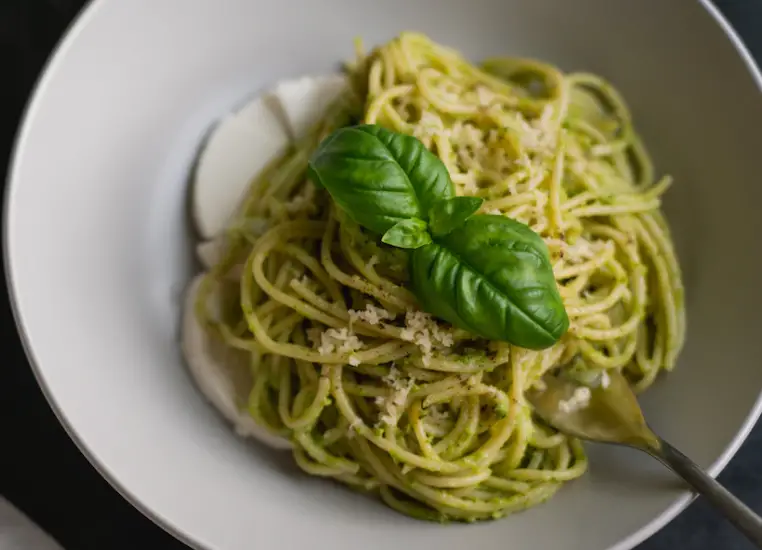Pesto, with its vibrant green hue and bold, herbaceous flavors, is a beloved sauce that can elevate any dish from ordinary to extraordinary. However, there’s nothing more disappointing than eagerly digging into a plate of pasta only to be met with an unexpected bitter taste. If you’ve found yourself pondering the question, “Why is my pesto so bitter?”, fear not! You’re not alone in this culinary conundrum. Let’s delve into the reasons behind bitter pesto and discover effective strategies to prevent and salvage your pesto masterpiece.

Reasons Behind Bitter Pesto
1. Olive Oil Quality Matters: One of the most influential factors contributing to bitter pesto is the quality of the olive oil used. If your olive oil is of inferior quality or has turned rancid, it can impart a bitter undertone to your pesto. Opt for higher quality, well-balanced olive oils to ensure a smoother, less bitter result.
2. Nut Selection and Preparation: The choice of nuts plays a crucial role in pesto bitterness. While pine nuts are traditional, walnuts are a common alternative due to cost. However, walnuts carry a hint of bitterness, especially if their skins are left on. To mitigate this, blanch walnuts to remove the skins and reduce bitterness. Alternatively, consider experimenting with other nuts like cashews, almonds, or pistachios for a milder flavor profile.
3. Basil and Flowering: Basil, the star ingredient in pesto, can sometimes be the source of bitterness. If your basil has started to bolt or flower, its taste may become bitter. To ensure a balanced pesto, use young basil leaves or regularly pruned basil that hasn’t yet flowered.
4. Blending Technique: Believe it or not, the way you blend your ingredients can influence the bitterness of your pesto. Over-blending olive oil can lead to oxidation, resulting in an unpleasant bitter taste. To avoid this, try blending other ingredients first and then gently incorporating the olive oil at the end.
How to Prevent Bitter Pesto
1. Opt for Quality Ingredients: Invest in high-quality, fresh ingredients to lay the foundation for a delicious pesto. Choose a reputable olive oil brand and ensure your nuts and herbs are at their peak of freshness.
2. Consider Nut Alternatives: While pine nuts are a classic choice, experimenting with different nuts can lead to unique and delicious pesto variations. Cashews, almonds, or a blend of pine nuts and sunflower seeds can offer a less bitter and equally satisfying pesto experience.
3. Keep an Eye on Basil: Regularly pruning your basil plant and using young leaves can help prevent bitterness. Avoid using basil that has started to bolt or flower.
4. Blend Mindfully: Be mindful of your blending technique. Blend ingredients other than olive oil first and gently incorporate the oil at the end to prevent over-oxidation and bitterness.
How to Save My Bitter Pesto
1. Add a Touch of Acidity: If your pesto turns out slightly bitter, avoid the urge to add sugar. Instead, try adding a squeeze of fresh lemon juice. The acidity of the lemon can help counteract the bitterness and brighten the flavors.
2. Nut and Herb Balance: If your pesto is too bitter due to walnuts or other nuts, consider blending in additional fresh herbs, such as parsley or mint, to balance out the flavors.
3. Creamy Dairy Rescue: To rescue an overly bitter pesto, consider incorporating creamy elements like grated Parmesan cheese or a dollop of Greek yogurt. These additions can help mellow the bitterness and create a more harmonious flavor profile.
4. Dilution with Unseasoned Ingredients: If your pesto is extremely bitter, you can try diluting it by adding more unseasoned ingredients like blanched vegetables, cooked pasta, or unsalted nuts. This can help temper the bitterness while maintaining the overall pesto essence.
Conclusion
Bitter pesto can be a frustrating setback in your culinary adventures, but armed with the knowledge of its potential causes and prevention strategies, you can confidently conquer this challenge.
By prioritizing quality ingredients, making mindful choices during preparation, and experimenting with alternative nuts and herbs, you can create pesto that delights your taste buds with its vibrant, balanced flavors.
And if your pesto does take an unexpected bitter turn, fear not; with a touch of creativity and some culinary finesse, you have the power to salvage your creation and turn it into a delightful culinary masterpiece.
So, roll up your sleeves, gather your ingredients, and let your pesto-making journey begin anew – this time, with the confidence to conquer the bitterness dilemma.

